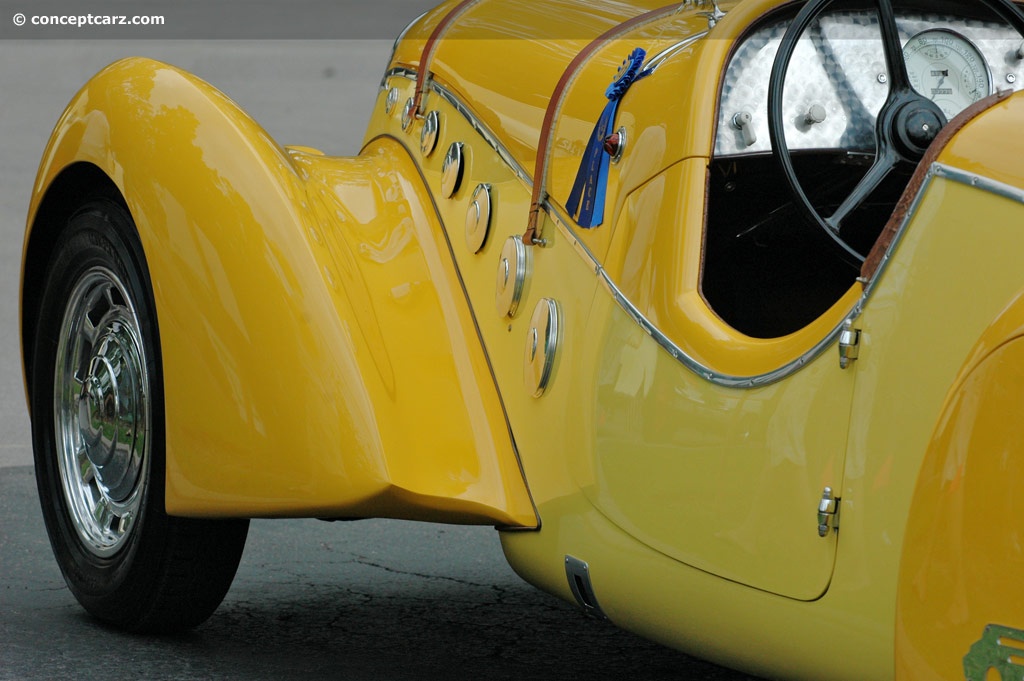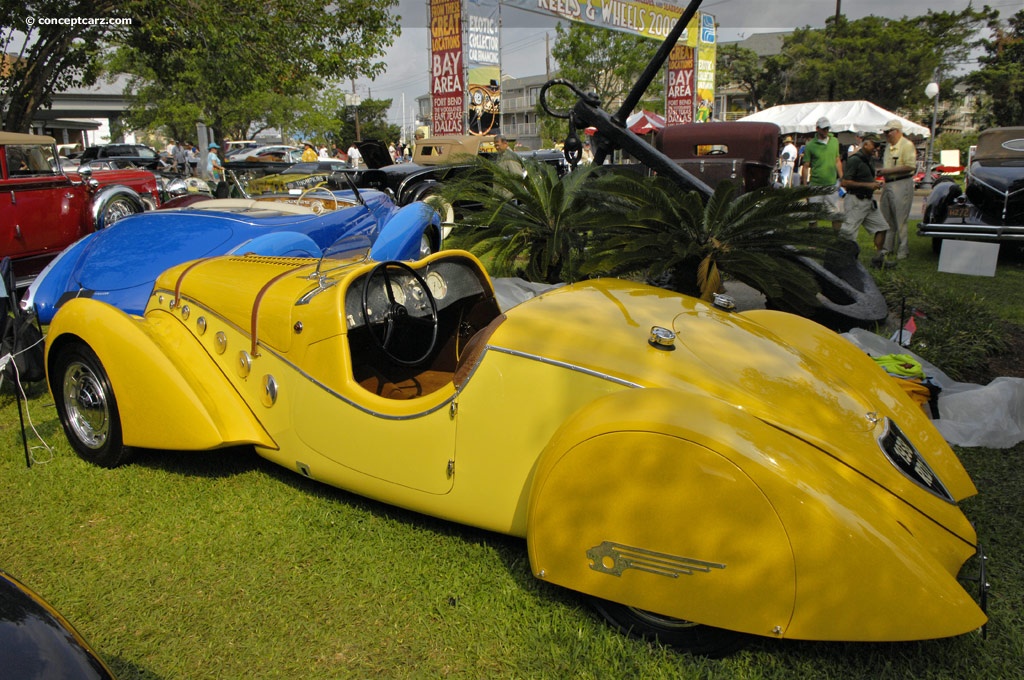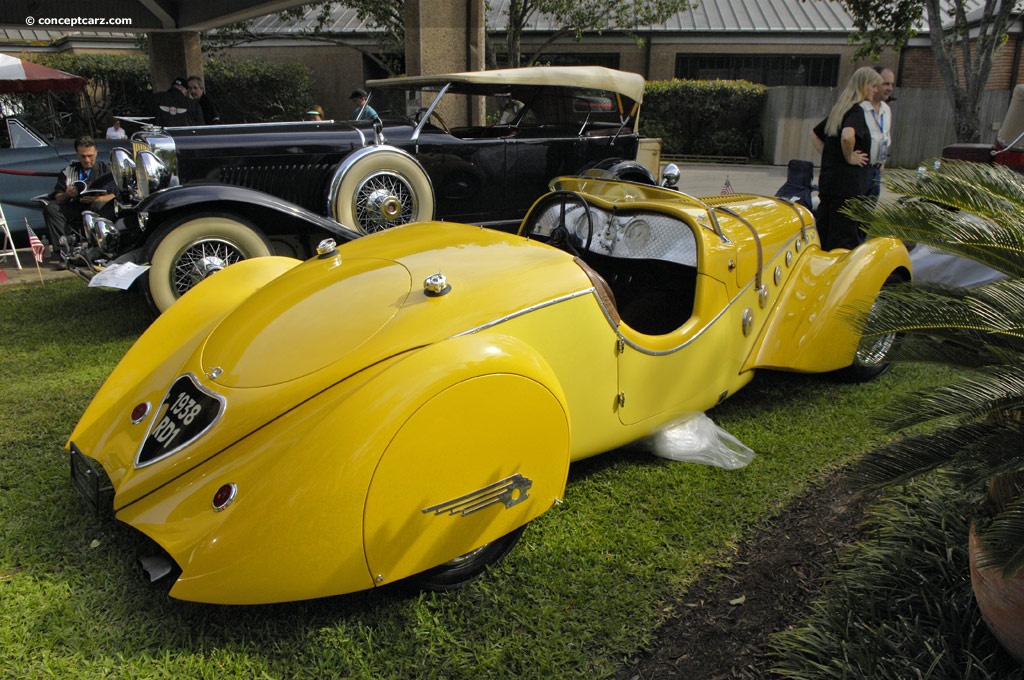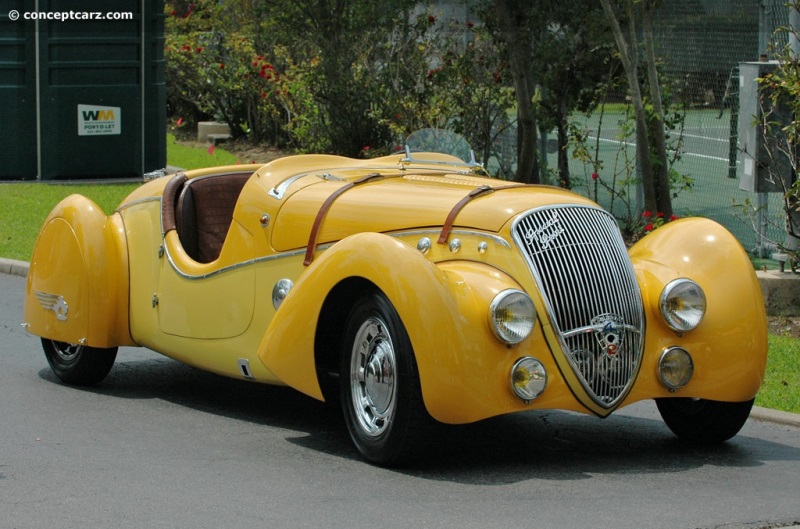Peugeot was a pioneer of the automobile and motor racing, producing its first three-wheeled, steam-powered car in 1889, and Albert Lemaître won the world's first motor race, the Paris–Rouen, in a 3 hp Peugeot. Before motor vehicle production, the company had established itself as a producer of tools, coffee mills, umbrella spikes and corsetry, commencing wheeled transportation in 1885 with the addition of cycle manufacture to its portfolio. Steam cars powered the early Peugeot vehicles, but this was quickly abandoned in favor of the internal combustion engine to Daimler design, building a succession of ever larger automobiles before introducing the first of its famous Bébé light cars in 1900. 
Roadster
Chassis #: 705516
View info and history
Auction entries : 2Peugeot continued to modernize its design, adopting the steering wheel in 1901 on the Type 36 and front-mounted engines for its 1902 models. Singles, twins and four-cylinder cars were produced at this time, some with chain and others with shaft drive, adopting the latter after 1909. Motorsports remained important to Peugeot, but its competition pedigree is not as distinguished as other French marques such as Talbot-Lago, Delage, Bugatti, and Delahaye. During a brief period, the mass-market manufacturer's prowess changed with the help of one of its principal dealers, producing a limited run of dynamic racecars that were equally potent on the track as they were in concour d'eleagance competition. The Peugeot 402
The Peugeot 402 was introduced in the mid-1930s, and approximately 75,000 examples would be produced through 1942. Styling was inspired by the Chrysler Airflow, with a sloping front end, and headlights positioned well back behind the grille. It was modern and innovative, offered in various wheelbase lengths with petrol and diesel engine options, and positioned as a big car at the high end of the volume car market. A standard three-speed manual and optional Cotal three-speed automatic was offered, and mechanical (cable-operated) drum brakes provided the stopping power. Initially, a 1991cc four-cylinder water-cooled engine with poppet valves and 55 horsepower propelled the car to a speed of around 75 mph. Displacement grew to 2,142cc in 1938 with the introduction of the Peugeot 402B, boosting output to 60 horsepower. Emile Darl'mat
Emile Darl'mat had a four-year apprenticeship with the French aviation pioneer Clément Ader. He established his own garage in Paris after World War I, where he repaired, tuned, and sold automobiles. He later became a licensed dealer of Panhards and Peugeots, and, by the early 1930s, was focused exclusively on Peugeot sales and service. His work in the automotive sector led him to the Bougival-based coachbuilder Marcel Pourtout and his chief stylist, Georges Paulin. Their earliest collaboration was put on display at the Paris Salon in 1927, and at the 1933 Chicago World's Fair, they presented a Peugeot 301 that was mounted with new aerodynamic coachwork designed by Paulin.A Return To Motorsports
By the mid-1930s, Peugoet had forged a solid reputation for its mass manufacture of pedestrian automobiles. The company's racing heritage included a successful series of grand prix cars built prior to World War I, and had even triumphed at the 1916 Indianapolis 500. Additional post-WWI accomplishments included victories by privateer André Boillot at several notable races, including the 1919 Targa Florio, the 1922 and 1925 Coppa Florio, the 1923 and 1925 Touring Car Grand Prix, and the 1926 24 Hours of Spa. Seeking a return to its motorsports roots, the company turned to Darl'mat, Pourtout, and Paulin to help them with this mission. The 302 Darl'mat Special Sport
Peugeot supplied Darl'mat with several chassis from the 302 series sedan in 1936. This was a junior model that rested on a shorter wheelbase than the 402 sedan, but used many of the same mechanical components, albeit with a smaller 1,750cc inline four-cylinder engine. Darl'mat replaced this engine with a 2-liter unit from the 402, and Jean Andreau, the director of the Aerodynamic Research Center, made modifications to prepare it for competition. Victor Derbuell, a supercharging expert, lent his services to this endeavor. The tuned two-liter, overhead-valve, four-cylinder engine received dual carburetors and was paired with a stout Cotal MK25 four-speed preselector gearbox.
Roadster
Chassis #: 705516
View info and history
Auction entries : 2The aerodynamic aluminum coachwork with Art Deco styling was penned by Paulin, incorporating a sloping front grille, streamlined chrome cues, dual rear glass panels, a vestigial boat-tail, medallion-shaped hood side vents, and unintegrated teardrop fenders. The hand-formed, lightweight bodies were constructed from thin aluminum sheets, with their sleek design perfected in the wind tunnel. When it was introduced in 1936 at the Paris Salon, the Peugeot 302 Darl'mat Special Sport was offered as a coupe, cabriolet, and roadster. Most of the cars were built with open coachwork and intended for competition. The competition versions were similar to their road-going stable-mates. The 1937 24 Hours of Le Mans
In preparation for the 1937 24 Hours of Le Mans, Peugeot lent Darl'mat its in-house Director of Mechanical Studies, Alfred Giauque. Three Darl'mat Special roadsters contested the race and all three finished admirably. The first Peugeot to cross the line, driven by Pujol/Marcel Contet, finished in 7th, followed by a second Peugeot in 8th, and the third example in 10th. The 402 Darl'mat Special Sport
Encouraged by the results of its three Darl'mat Special roadsters, and convinced that the cars did not necessarily need a large engine if it was effectively streamlined, Peugeot upped the ante for 1938, providing Darl'mat with the 402 Légère (lightweight) chassis. It was wider and shorter than its predecessor and would become the basis for the Peugeot 402 Darl'mat Special, again built in both closed and open-body styles.
Roadster
Chassis #: 705516
View info and history
Auction entries : 2Returning to Le Mans in 1938, the Peugeot driven by Charles de Cortanze and Marcel Contet finished 5th overall and won the 2-liter class. Despite its success, this would be the final year the Peugeot Darl'mat Specials raced at Sarthe. Production
The total production of all variants of the Darl'mat Special Sport reached 105 examples, including 20 coupes, 32 cabriolets, and 53 roadsters. Peugeot 402 Éclipse
The Peugeot 402 Éclipse was the first model to employ a system that allowed the roof to fold into the boot, transforming a hard-top coupé into an open-top cabriolet using a hand-operated mechanism. The design was created by Georges Paulin in 1931 and built by Pourtout, and the early examples were for clients of Darl'mat. Peugeot later built its own model using this design on its 401 and 402 models.
Roadster
Chassis #: 705516
View info and history
Auction entries : 2The early designs were very bulky which required the vehicle to have a very long tail to stow the steel roof. Despite having a 124-inch wheelbase, these early vehicles had seating for just two occupants. The 'Eclipse' technology on the 402 'long' (130 inch) wheelbase chassis had seating for 4/5 people. As many as 450 examples of the Eclipse were built prior to the outbreak of World War II.
by Daniel Vaughan | Aug 2023

Roadster
Chassis #: 705516
View info and history
Auction entries : 2
The Peugeot 402 was introduced in the mid-1930s, and approximately 75,000 examples would be produced through 1942. Styling was inspired by the Chrysler Airflow, with a sloping front end, and headlights positioned well back behind the grille. It was modern and innovative, offered in various wheelbase lengths with petrol and diesel engine options, and positioned as a big car at the high end of the volume car market. A standard three-speed manual and optional Cotal three-speed automatic was offered, and mechanical (cable-operated) drum brakes provided the stopping power. Initially, a 1991cc four-cylinder water-cooled engine with poppet valves and 55 horsepower propelled the car to a speed of around 75 mph. Displacement grew to 2,142cc in 1938 with the introduction of the Peugeot 402B, boosting output to 60 horsepower. Emile Darl'mat
Emile Darl'mat had a four-year apprenticeship with the French aviation pioneer Clément Ader. He established his own garage in Paris after World War I, where he repaired, tuned, and sold automobiles. He later became a licensed dealer of Panhards and Peugeots, and, by the early 1930s, was focused exclusively on Peugeot sales and service. His work in the automotive sector led him to the Bougival-based coachbuilder Marcel Pourtout and his chief stylist, Georges Paulin. Their earliest collaboration was put on display at the Paris Salon in 1927, and at the 1933 Chicago World's Fair, they presented a Peugeot 301 that was mounted with new aerodynamic coachwork designed by Paulin.A Return To Motorsports
By the mid-1930s, Peugoet had forged a solid reputation for its mass manufacture of pedestrian automobiles. The company's racing heritage included a successful series of grand prix cars built prior to World War I, and had even triumphed at the 1916 Indianapolis 500. Additional post-WWI accomplishments included victories by privateer André Boillot at several notable races, including the 1919 Targa Florio, the 1922 and 1925 Coppa Florio, the 1923 and 1925 Touring Car Grand Prix, and the 1926 24 Hours of Spa. Seeking a return to its motorsports roots, the company turned to Darl'mat, Pourtout, and Paulin to help them with this mission. The 302 Darl'mat Special Sport
Peugeot supplied Darl'mat with several chassis from the 302 series sedan in 1936. This was a junior model that rested on a shorter wheelbase than the 402 sedan, but used many of the same mechanical components, albeit with a smaller 1,750cc inline four-cylinder engine. Darl'mat replaced this engine with a 2-liter unit from the 402, and Jean Andreau, the director of the Aerodynamic Research Center, made modifications to prepare it for competition. Victor Derbuell, a supercharging expert, lent his services to this endeavor. The tuned two-liter, overhead-valve, four-cylinder engine received dual carburetors and was paired with a stout Cotal MK25 four-speed preselector gearbox.

Roadster
Chassis #: 705516
View info and history
Auction entries : 2
In preparation for the 1937 24 Hours of Le Mans, Peugeot lent Darl'mat its in-house Director of Mechanical Studies, Alfred Giauque. Three Darl'mat Special roadsters contested the race and all three finished admirably. The first Peugeot to cross the line, driven by Pujol/Marcel Contet, finished in 7th, followed by a second Peugeot in 8th, and the third example in 10th. The 402 Darl'mat Special Sport
Encouraged by the results of its three Darl'mat Special roadsters, and convinced that the cars did not necessarily need a large engine if it was effectively streamlined, Peugeot upped the ante for 1938, providing Darl'mat with the 402 Légère (lightweight) chassis. It was wider and shorter than its predecessor and would become the basis for the Peugeot 402 Darl'mat Special, again built in both closed and open-body styles.

Roadster
Chassis #: 705516
View info and history
Auction entries : 2
The total production of all variants of the Darl'mat Special Sport reached 105 examples, including 20 coupes, 32 cabriolets, and 53 roadsters. Peugeot 402 Éclipse
The Peugeot 402 Éclipse was the first model to employ a system that allowed the roof to fold into the boot, transforming a hard-top coupé into an open-top cabriolet using a hand-operated mechanism. The design was created by Georges Paulin in 1931 and built by Pourtout, and the early examples were for clients of Darl'mat. Peugeot later built its own model using this design on its 401 and 402 models.

Roadster
Chassis #: 705516
View info and history
Auction entries : 2
by Daniel Vaughan | Aug 2023
Related Reading : Peugeot 402 History
With a rich history of technical innovation, Peugeots 402 cars have become some of the most respected Peugeots that France ever produced. But even more impressive than the cars themselves were the people behind the curvaceous vehicles. World War II was swinging closer when the 402 was released in 1935, and by the end of the cars production run in 1940 the world had already fallen into one of the....
Continue Reading >>
Continue Reading >>
Similar Vehicles
Similarly Sized Vehicles
from 1937
1937 Peugeot 402 Darl Mat Vehicle Profiles
Recent Vehicle Additions
Performance and Specification Comparison
402 Darl'mat Special Sport Roadsters Specification Comparison by Year
Year
Production
Wheelbase
Engine
Prices
4 cyl., 122.05 CID., 70.00hp
Related Automotive News

Prestigious European Classics, Including Exceptional 1933 Bugatti Type 55 Roadster, Added to Gooding & Company's Pebble Beach Auctions
A selection of highly desirable concours-quality offerings from Europes finest automakers, including Bugatti, Bentley, Alfa Romeo, and Peugeot, to cross the auction block at Pebble Beach next month.
Internationally acclaimed auction house Gooding...

A Comparison of 1997 Best of Show and 2022 Best of Show Nominee at the Pebble Beach Concours d'Elegance
Left 1997 Best of Show Right 2022 Best of Show Nominee
The combined efforts of Talbot-Lago and Figoni %26 Falaschi resulted in many wondrous automotive creations, including the T150C model with goutte deau, literally a drop...

Bonhams Motor Cars First Digital-Only Sale Features French Classic Darl'mat
Rare 1938 Peugeot 402 DSE DarlMat Special Sport offered in new timed online format auction from 3-10 March
Bonhams Les Grandes Marques du Monde à Paris Sale will be held as a fully digital auction, the first for Bonhams Motor Cars, rescheduled...

Concours d'Elegance of America : Best of Show
image0
The 38th Concours dElegance of America displayed over 300 of the worlds most spectacular contributions to automotive history. This year, the event paid tribute to many special features inclduing Ford GT-40s, Body by Dietrich, Rally Cars,...

FRENCH HISTORY TAKES CENTRE STAGE AT RM'S PARIS COLLECTOR CAR AUCTION AT PLACE VAUBAN
RM Auctions returns to the stunning Place Vauban for its second annual collector car sale in Paris, 4 February, 2015
Held during the world-famous Retromobile week, the multi-million euro sale features a magnificent selection of 60 blue-chip motor...


































